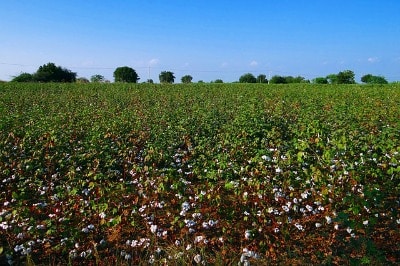Fiber crops are plants that are intentionally grown or otherwise managed for the production of fibers or fibrous materials with varied uses but not for dietary purposes.
Fibers are mainly schlerenchyma cells that serve as component of plant skeleton and are often associated with vascular tissue.
These are usually long cells with pointed ends which typically occur in strands.
Any part of the plant such as the root, stems, leaves, fruits and seeds can have fibers but they differ in characteristics such as texture, length, color, strength, and chemical composition.
The abaca or Manila hemp, considered as the world’s premier fiber crop for making cords and ropes, has fibers which can reach 3 meters long.
These fibers have reportedly been used as composite materials in the manufacture of certain parts of cars (Obmerga 2011).

In contrast, dietary fibers are those found naturally in foods and which are promoted for their health benefits.
As to chemical composition, they are classified into the carbohydrate and noncarbohydrate types.
The carbohydrate types are primarily composed of cellulose, hemicelluloses, pectins, gums, and mucilages which are non-starch polysaccharides, while the noncarbohydrate types are composed of lignins made up of a multiringed alcohol structure.
Dietary fibers are not digestible by humans but they have been found to have beneficial physiological effects such as increase in fecal bulk, decrease in intestinal transit time, delay in gastric emptying, and slowing of glucose absorption.
Major food sources of dietary fibers include whole grains, vegetables, and many fruits (Wardlaw et al. 2004).
There are several ways of classifying fibers derived from fiber crops.
As to location, fibers can be either xylary fibers if found in the xylem or extraxylary fibers if they occur elsewhere.
Extraxylary fibers are important in the manufacture of fabrics because they are usually longer than xylary fibers (Moore et al. 2003).
As to origin, they can be further classified into bast fibers, wood fibers, leaf fibers, and surface fibers.
Bast fibers are obtained from the outer parts of the stem while surface fibers refer to the hair-like projections as in the seeds of cotton.
But Hill (1972) advised that for clarity on the morphological origin of bast fibers, the following descriptive terms can be used: cortical fibers, pericyclic fibers, and phloem fibers.
According to Moore et al. (2003), fibers in cotton are not schlerenchyma but trichomes which are epidermal outgrowths up to 6 cm long.
The major fiber crops are also differentiated according to the main usage of their fibers although any one fiber can have multiple uses.
Classification of fibers
Based on how they are primarily utilized, fibers can be classified into the following six groups according to Hill (1972):
- Textile Fibers. The fibers are used in the manufacture of fabrics, netting and cordage or ropes.
- Brush Fibers. The fibers, as well as twigs, small stems and other plant parts, are used in making brushes and brooms.
- Plaiting and Rough Weaving Fibers. Strands of fibrous materials are used in the manufacture of various articles such as hats, sandals, hammocks, plaited walls, chair seats, matting, roof thatching, baskets, etc.
- Filling Fibers. The fibers are used as stuffing material in making mattresses, pillows, cushions, and in upholstery.; for caulking; and as packing materials.
- Natural Fabrics. Barks of certain trees are pounded to form rough substitutes for cloth or lace.
- Papermaking Fibers. These consist primarily of wood fibers but also include other plant parts for the manufacture of different kinds of paper including handmade paper.
It is interesting to note that, according to Feininger (1968), the single edition of The New York Times of December 3, 1961 (678 pages; 1,458,558 copies) required 4,550 tons of paper manufactured from wood pulp obtained from more than 77,000 trees with average age of 70 years.
This means that one such tree then produced at most about 60 kilograms of paper.
It seems also that millions of trees must be felled in order to sustain the daily need for papers throughout the world.
For the fiber crops considered important in the textile industry, they are desired for the following charateristics of their fiber:
(1) long with high tensile strength;
(2) cohesive and pliable;
(3) fine, uniform and lustrous; and
(4) durable.
The textile fibers are subdivided into three classes:
(1)surface fibers,
(2) soft or bast fibers,
and (3) hard or structural fibers.
The soft and hard fibers are usually referred to as long fibers (Hill 1972) but differ in hardness or flexibility which is associated with lignin.
Soft fibers from many dicots are softer in texture and more flexible than hard fibers because they lack lignin, a major structural component of wood, or contain only minimal amounts of it.
In contrast, hard fibers obtained from most monocots also include lignified xylem.
The soft linen derived from flax is woven from phloem fibers which consist almost entirely of cellulose.
Cotton fibers are also flexible and soft being made up of 95% cellulose.
In general, fibers from dicots are more stronger and durable than those obtained from monocots (Moore et al. 2003).
With a few exceptions, the hard fibers are derived from leaves or part of leaves, i.e., leafstalks in abaca.
A fiber called coir is extracted from the husks of coconut.
LITERATURE CITED
- FEININGER A. 1968. Trees. New York, NY: The Viking Press. p. 10.
- HILL AF. 1972. Economic Botany: A Textbook of Useful Plants and Plant Products. 2nd ed. New Delhi: Tata McGraw-Hill Publishing Company Ltd. p. 18-51.
- MOORE R, CLARK WD, VODOPICH DS. 2003. Botany. 2nd ed. International Student Edition. New York, NY: McGraw-Hill Companies, Inc. 919 p.
- OBMERGA AR. 2011. RP studies abaca fiber for local car manufacture industry. Retrieved December 16, 2011 from http://www2.ptri.dost.gov.ph/index.php?option=com_content&task;=view&id;=104.
- WARDLAW GM, HAMPL JS, DiSILVESTRO RA. 2004. Perspectives in Nutrition. 6th ed. New York, Y: McGraw-Hill Companies, Inc. p. 137-170.
